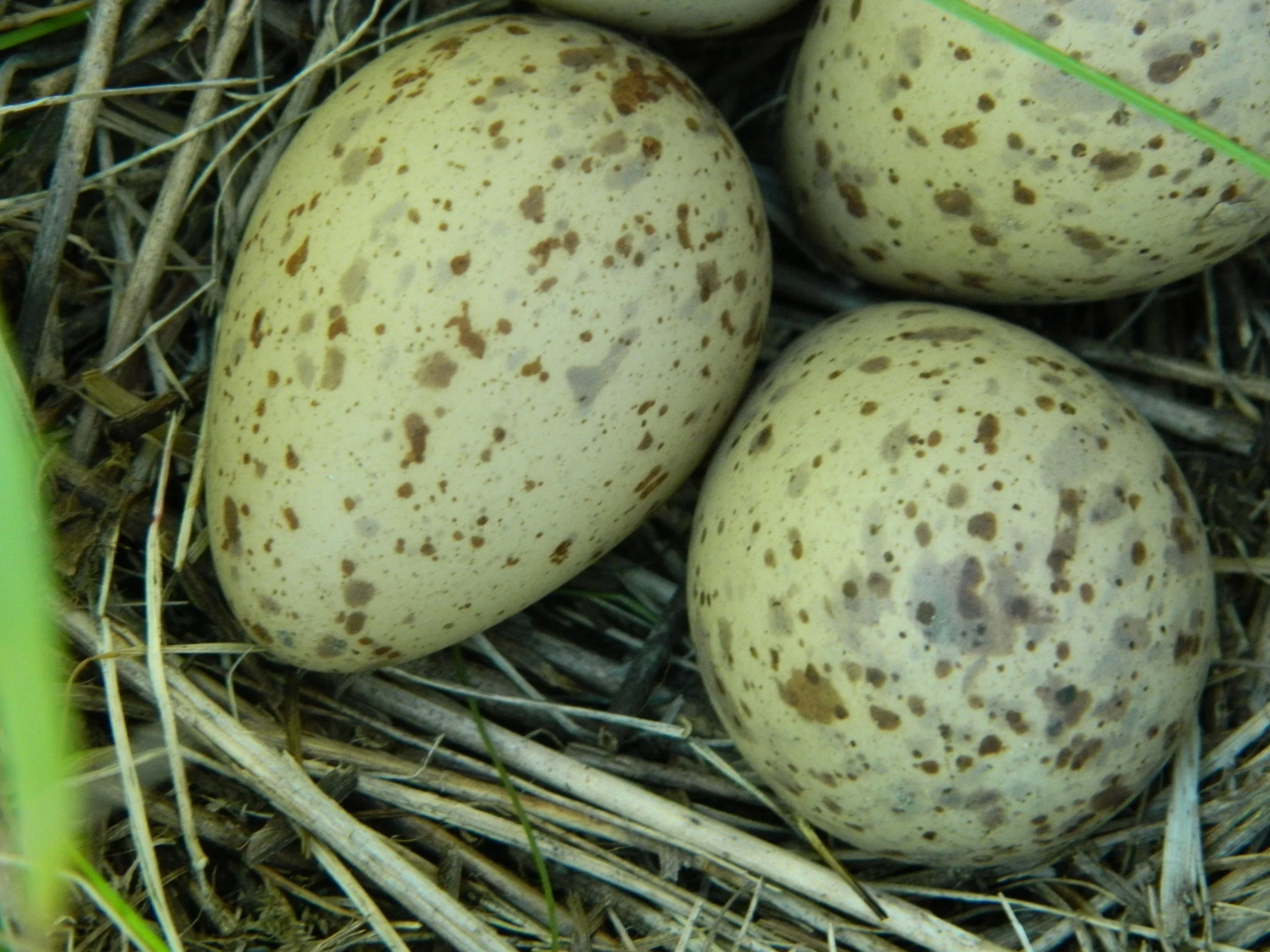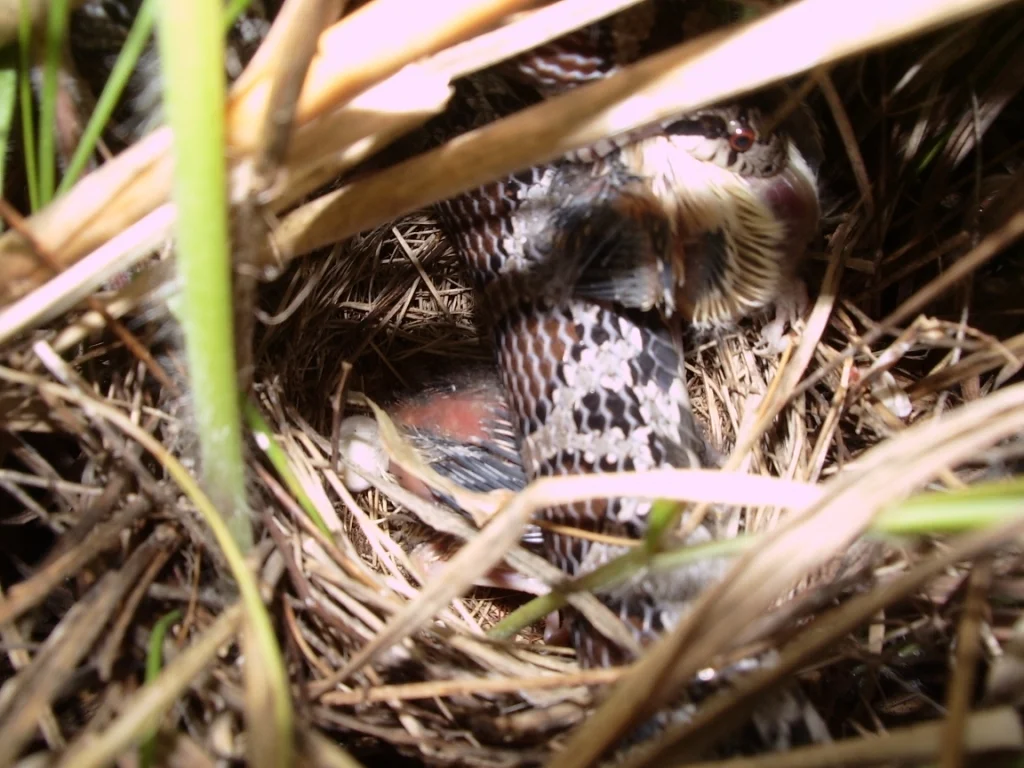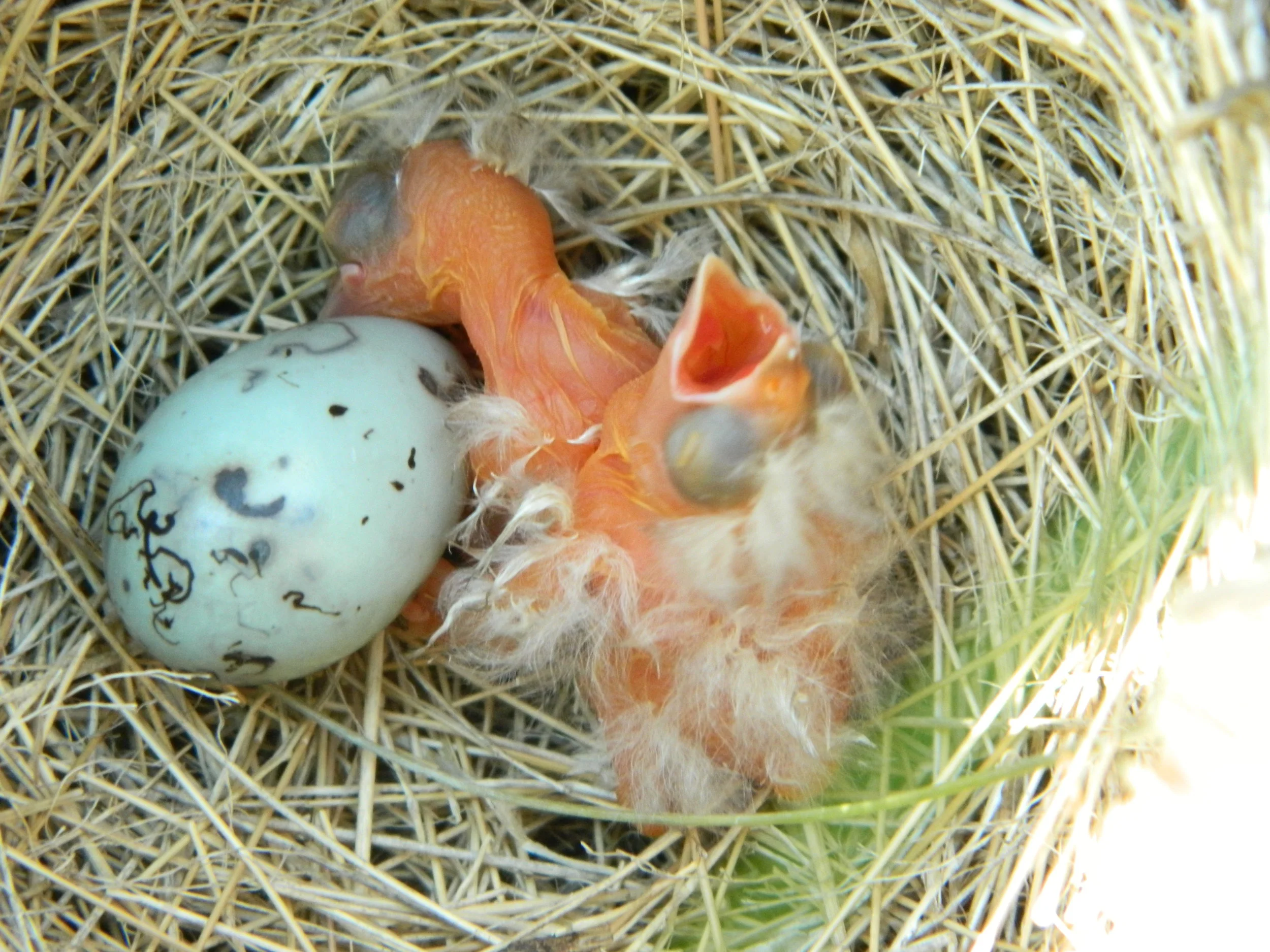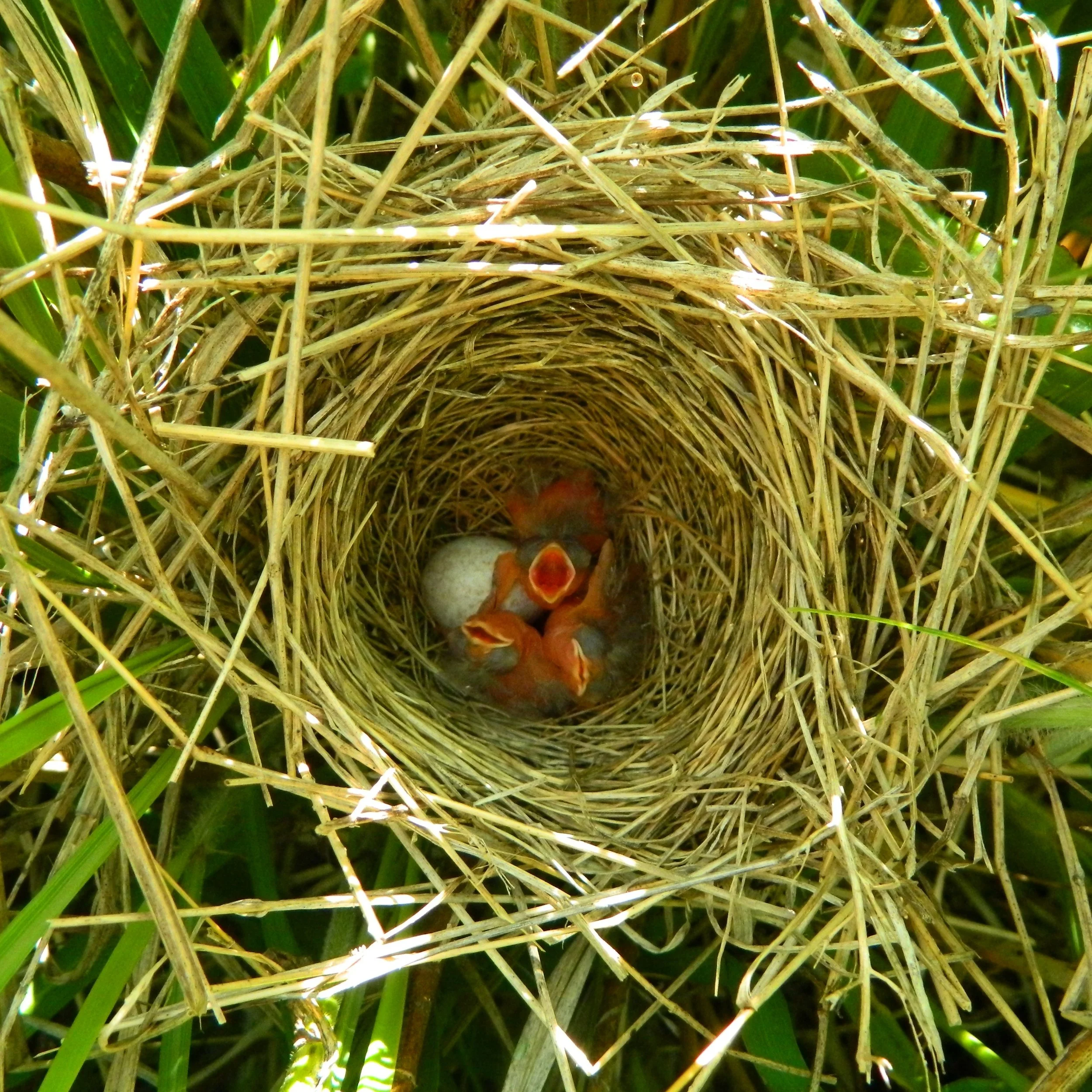Explore how grassland birds make nesting in the prairie a beautiful yet dangerous part of life...

Northern harrier chicks. Photo by Carolyn Byers
Grassland birds lead hidden lives under the thick cover of prairie plants. What does this ground-level existence look like? What does it take to get a new brood of young to fledge and survive?
Southern Wisconsin Bird Alliance’s education director Carolyn Byers will open your eyes to the world of grassland birds and their nesting ecology through our new series, Into the Nest. Regular posts with short essays, photos, and nest camera videos will reveal the advantages, challenges, coziness, and dangers of nesting in the prairie, and how you can help these fascinating and vulnerable birds.
Don't miss any of the Into the Nest posts, all listed below from newest to oldest (so early season starts at the bottom of the page).

Posts are listed from newest to oldest (so early season starts at the bottom of the page).
Our last post shared some pretty intense videos of predation events at nests. In both videos all of the chicks got eaten, and the parents either fled or did not approach the nest while the predator was there. The badger and the 13 lined ground squirrel weren’t challenged as they made off with nestlings. It’s not always like this, though. It turns out that bird parents respond differently depending on who is trying to eat their chicks.
Photo courtesy of Ribic research lab
While adult birds and eggs are vulnerable during incubation, they are at even greater risk after chicks hatch. Most of our grassland birds are altricial as chicks, and need to stay in the nest long enough to be reasonably mobile when they fledge. However, chicks are also very vulnerable in the nest: they stay in one place, and the noise and activity surrounding the nest can attract predators. These birds need to balance the benefits of staying in the nest until they are able to fly to forage and escape predators with the potential risks of being found by predators while still in the nest.
Photo by James Perdue
A lot of people really dislike - even hate - cowbirds. I get it. It can be hard to watch a small warbler trying to keep a huge cowbird chick fed, and it’s sad when host species eggs get destroyed. But objectively and unemotionally, cowbirds are amazing, smart, resilient, and cool. Their reproductive strategy allows them to produce many more offspring than the average bird. Hopefully by the end of this post, you’ll be thinking about cowbird behavior in a new light too.
Photo by Carolyn Byers
Keeping the nest clean is a pretty big deal. Some large raptors are able to defend their nest from nearly anything, so it doesn’t matter how messy they are. Not so for our grassland birds. They are ill-equipped to fight back against most predators, and fare much better when they’re able to go unnoticed. Dirty nests could smell strongly, and attract curious - and hungry! - mammalian predators.
Photo by Carolyn Byers
It's been a little bit since we've peeked Into the Nest of grassland birds. But not because of a lack of interesting stuff to talk about! We are working on a run down of everyone's favorite topic: poop; you won't want to miss the upcoming post on fecal sacs.
In the meantime, feast your eyes on these awesome eggs. The size, shape, color pattern are all unique to the species they come from. Learn more about how grassland birds lay their clutch of beautiful eggs in our Into the Nest post from May 31: There is nothing so beautiful as a bird's egg.
Artwork by Carolyn Byers
Now that the chicks have hatched, they are in almost constant need of food. Grassland bird chicks generally fledge in about 10 days, and their growth rates are incredible. Parents must balance all of their chicks’ needs - food, thermoregulation, protection from predators, and shelter- to maximize their chances of survival.
Photo by Carolyn Byers
Raising chicks in a grassland is challenging enough, but prairie storms take it to a whole new level. This grasshopper sparrow is trying to keep her chicks warm and dry despite the thunderstorm, but these rowdy young'uns keep bouncing her around. The chicks are 8 days old, and close to fledging. Sometimes at this stage, the adults will leave the chicks on their own and go catch some shut-eye somewhere nearby. (Sound familiar to anyone?) I don't blame them!
While incubating eggs looks pretty boring, it seems easy enough. Stay quiet and hidden. Don’t attract predators to the nest. Keep the eggs at an ideal temperature and rotate them frequently. All of that changes as soon as there are chicks in the nest.
Photo by Carolyn Byers
The grassland birds that we’ve been following this summer have completed the arduous journey back to Wisconsin, set up territories, and found mates. They have built a nest and laid a clutch of breathtakingly beautiful eggs. Now they need to ensure the eggs survive until hatching-- no small feat.
Photo by VSPYCC
Most birds lay their eggs in the early morning. This is likely because carrying a large, fragile egg within the oviduct throughout the day could be risky! Gravid female birds (those carrying eggs) are weighted down by their cargo, and may have trouble avoiding predators. Laying an egg is also a vulnerable time for a bird, and early morning laying may minimize their chance of being disturbed by predators (Gill 2007).
Photo by Carolyn Byers
Grassland bird nests are just about my favorite things ever. They’re perfect little secrets hiding in the foliage, holding precious babes. I love the way they are often fairly similar, but have subtle differences that let you identify who built them. (Sparrows are my favorite group of birds, which might explain why I love small brown things that look alike!) Nest searching is tricky business too -- and it feels like an incredible accomplishment when you find one.
Photo by Carolyn Byers
Territories are used for a variety of activities, and their size can vary dramatically depending on their function. A territory held by a colonial seabird may only be large enough for the bird’s nest, and all other activities would take place outside of the territory. Territories may be used only for mating displays. Other birds may hold territories large enough to encompass all of the resources they will need throughout the season. They may be carefully defended year round, or held only for part of the year. Birds typically exclude only their own species from their territory, but may work to defend it from other species too.
Photo by Joshua Mayer
Last week our grassland birds were on an epic journey north to Wisconsin. They made this monumental trek to gain access to the huge flush of productivity that occurs in the northern spring and summer. This food bonanza will make raising a brood a hungry chicks easier, and makes the hard migration worth it in the long run.
So what happens to our birds after they arrive back in Wisconsin? They search for habitat and work towards setting up territories.
Photo by Joshua Mayer
We all have a scene that pops into our heads when we think of ‘grassland birds’. Maybe you simply think of the birds themselves. Perhaps you see sunlight glistening on dewy prairie, while a northern harrier floats a few feet above the grass. Do you hear a dawn chorus of bobolinks and eastern meadowlarks punctuated by the quiet whisper of Henslow’s sparrow? Whatever image you conjure, I imagine it warms your heart.
Photo by Arlene Koziol
Welcome to our new series, entitled “Into the Nest”! This spring and summer, we will take you through the entire process, start to finish, on how a grassland bird chooses, creates, populates, protects, and fledges young from a nest. We hope you enjoy!
Photo by Carolyn Byers
Banner photo: Upland sandpiper nest and eggs, photo by Carolyn Byers




















We know that human kids grow, mature, and gradually move towards a life that is independent of their parents’ home. The same is true for baby birds: they also have to decide when the time is right to leave the nest and start on their journey to independence. This seems to involve a balancing act between making sure they are big and healthy enough to survive independently, while leaving the nest quickly to avoid predators.
Photo: Kelly Colgan Azar